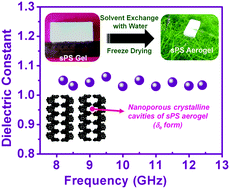Aerogels of hierarchically porous syndiotactic polystyrene with a dielectric constant near to air†
Abstract
Herein ultralow density aerogels are developed through a feasible freeze casting technique. Briefly, the syndiotactic polystyrene (sPS) gel was prepared using xylene and subjected to successive steps of solvent exchange using non-solvents like ethanol and water. These samples were freeze-dried to obtain aerogels of the same shape and size as gels. The aerogels obtained exhibited the lowest ever dielectric constant of any polymer aerogel (κ = 1.03 ± 0.02), which is very close to that of air. Moreover, while analyzing the crystal structure, it was observed that the water derived sPS aerogel existed in the empty δ (δe) form, with microcavities in the crystal lattice in addition to meso and macroporosity. However, annealing at different temperatures yielded aerogels with different polymorphic forms without microporosity leading to slight variations in the dielectric constant. The microporosity in the crystalline state along with the lower density of the material were proven to be the major contributing factors to the lowest ever reported dielectric constant of the sPS aerogel. The sPS aerogels with an ultra low dielectric constant, very high hydrophobicity and adequate mechanical strength can stand as an alternative to conventional brittle inorganic aerogels.



 Please wait while we load your content...
Please wait while we load your content...